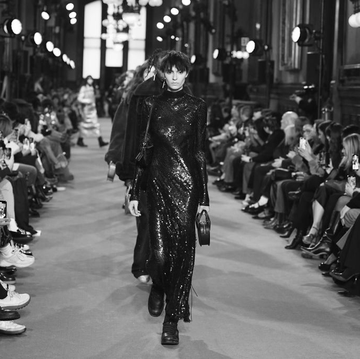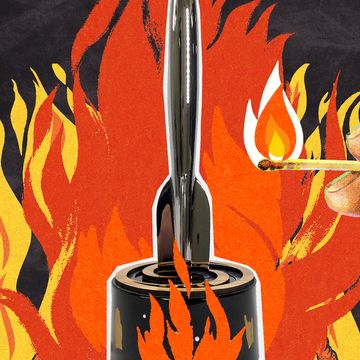Bullfight-lover. Big game hunter. Deep sea fisher. Brawler. Boxer. Drinker. War hero. Ladies' man. Even for his time, Ernest Hemingway was masculinity in hyperbole. The outsized writer of stripped-back prose was also, a new documentary argues, an explorer of gender fluidity in the bedroom – both in his literature and his life. At a cultural moment which favours simplistic interpretations of iconic figures as villains or heroes, American filmmakers Ken Burns and Lynn Novick muddy the waters of the fallen literary celebrity in Hemingway, their non-hagiographic, six-hour examination of the contradiction between the myth and the man.
“For us it's about making things more complex,” Burns tells me, on a call from his home in Walpole, New Hampshire. “Hemingway is monstrous at times and there's never a moment in the film where we let him off the hook.” The writer’s epic and, ultimately, tragic life allowed him to create literature – considered to be among the most influential in the English language – that Burns says belies the imprisoning masculinity that he’s known for. “He shows how incredibly difficult it is to have an on-off switch. That black-white, good-bad labelling may be the de rigueur activity, but there's nothing binary about the world.”
This quest for nuance is key in understanding Hemingway’s marital bed. In the film, biographer Mary Dearborn calls him “brave” for his “sexual preferences” and admission to an “intense desire” for role play. “He really had a thing about androgyny and he liked to switch sex roles in bed, and he tells Mary [Walsh Hemingway, his fourth wife], ‘Let’s play around, I’m gonna call you Pete, you call me Catherine.’”
In her journal, Mary wrote that he was the best man she’d been with in bed. He “wanted his wife to be both completely obedient and sexually loose.” She “enjoyed the sexual part, cut her hair short and bleached it platinum, because it excited him, and sometimes pretended that she was a boy and he was a girl,” the narrator (longtime Burns collaborator Peter Coyote) tells us. “He dyed his hair too.”
The film voices a condensed excerpt from Hemingway’s entry in Mary’s diary while the two were on safari in East Africa in 1953:
She has always wanted to be a boy and thinks as a boy without losing any of her femininity. If you should become confused on this, you should retire. She loves me to be her girls, which I love to be, not being absolutely stupid... In return she makes me awards, and at night we do every sort of thing which pleases her and which pleases me. […] I loved feeling the embrace of Mary, which came to me as something quite new and outside all tribal law.
Was the gender swapping simply code for Hemingway’s enjoyment of every sort of thing outside all tribal law – like anal penetration? Does “being the girl” just mean being the one penetrated? Was Hemingway an early, literary proponent of pegging?
“I don't know,” Burns told me. “This is a really important question, something's clearly happening in that diary entry and in Garden of Eden. It certainly opens a door to that consideration.”
The Garden of Eden is a posthumously published novel that overlaps, in many ways, with Hemingway’s life – including the matching hair and sex play. In the film, the writer Michael Katakis says the novel exposes things that “some people would find shocking” about Hemingway. “He’s not hiding himself.”
The book focuses on a couple honeymooning in the French Riviera in 1927 (the spot of Hemingway’s honeymoon with his second wife, Vogue editor Pauline Pfeiffer). David, an author and war veteran, and Catherine spend their days eating, tanning, drinking, and having sex. One day Catherine returns to the hotel with a surprise for David. She cut her hair "cropped as short as a boy's." Later in bed, when David calls her "girl" Catherine tells him, "Don't call me girl." Then she asks, "Will you change and be my girl and let me take you? [….] I'm Peter. You're my wonderful Catherine." The two meet and fall in love with Marita, who becomes a proto-polyamorous lover to both.
Hemingway said the book was “too sexually adventurous” to be published in his lifetime, and he was right. It wasn’t released until 1986, 25 years after he shot himself in his home in Ketchum, Idaho. Rounds of electroshock therapy prescribed for depression had caused a loss in Hemingway's short-term memory, rendering him unable to write. Numerous concussions, self-medication with prescription drugs, and decades of alcoholism didn’t help, but depression and suicide ran in the family. His father, sister, brother, and granddaughter also killed themselves. There’s a painful scene in the film where Hemingway gives a rare interview, after winning his Nobel Prize in 1954, with his speech impaired.
After the book came out, Joan Didion – who, like Ralph Ellison, would retype Hemingway’s stories to learn his style – lamented its publication in The New Yorker. How ethical is it to publish an unfinished book against an author’s wishes – an author who cared about every period, comma, and article?
And yet, he didn't destroy it either.
Pegging Papa
Ethics aside, the book does offer essential insight. For one, the anal penetration in The Garden of Eden is “pretty well accepted” by critics familiar with the original manuscript, according to Debra Moddelmog, dean of the College of Liberal Arts at the University of Nevada, Reno. In Reading Desire, Moddelmog points out a revealing phrase Hemingway had crossed out, which contains more explicit detail: David felt “something that yielded and entered.” In the published novel,
[David] lay there and felt something and then her hand holding him and searching lower and he helped with his hands and then laid back in the dark and did not think at all and only felt the weight and the strangeness inside and she said, “Now you can’t tell who is who can you?”
What entered?
“I think this is digital anal penetration,” Moddelmog tells me (a 2010 film adaptation agrees), “but there’s room for interpretation.” Of course, the “something” and the “weight” could easily be an implement heavier than fingers. The game is repeated many times. And absinthe helped to cure David’s “remorse” when, one day, while visiting Spain, the penetration occurred when he and Catherine were both “boys.”
The late Richard Fantina’s “Pegging Ernest Hemingway”, from his book Straight Writ Queer, offers another take. “In Hemingway’s work the male heroes seldom penetrate women but rather are sometimes penetrated themselves,” he writes. Male submission is part of the back door sex for Fantina: “The ideal Hemingway woman”, like sexually liberated Brett Ashley in The Sun Also Rises (1926), “demonstrates power and a will to dominate.” In The Garden of Eden, Hemingway “celebrates a woman who controls the sexual relationship with her husband and who initiates female-on-male sodomy.” Sodomy, Fantina argues, is a “polymorphous practise that transcends categories of gender and sexual preference.”
In her diary, during that previously mentioned 1953 African sex safari, Mary Hemingway wrote: “Papa’s definition of buggery: ‘Sodomy when practised by those who are not gentlemen.’” A few lines away from that is an account of their afternoon nap: a “love-feast, love-fest, love fiesta,” and another entry later that night noted “a bigger, happier, lovelier, love-fest-feast.” There’s also her account of Hemingway’s mock interview:
REPORTER: ‘Mr. Hemingway, is it true that your wife is a lesbian?’
PAPA: ‘Of course not. Mrs Hemingway is a boy.’
REPORTER: ‘What are your favorite sports, sir?’
PAPA: ‘Shooting, fishing, reading and sodomy.’
REPORTER: ‘Does Mrs Hemingway participate in these sports?’
PAPA: ‘She participates in all of them.’
REPORTER: ‘Sir, can you compare fishing, shooting and cricket, perhaps, with the other sports you practise?’
PAPA: ‘Young man, you must distinguish between the diurnal and the nocturnal sports. In this later category sodomy is definitely superior to fishing.’
Icebergs and Enemas
In 1918, Hemingway was in hospital in Milan after being wounded while volunteering as an ambulance driver on the Italian front during World War I. In preparation for an operation, he was likely given an enema by nurse Agnes von Kurowsky – his first great love. This enema was replicated in A Farewell to Arms, when Catherine administers one to Frederic, a lieutenant of the ambulance core, before his operation.
The word 'enema' is never used. The reader must infer from his lover-nurse making him “clean inside and out.”
In Hemingway’s pared-down 'iceberg' technique of layered writing, it's what’s unsaid, left beneath the surface, that matters. That omission entailed excising chunks of text and giving the reader the generous credit to intuit the absence. In his 1927 short story, “Hills Like White Elephants,” a man pressures a woman to get an abortion, and the word abortion is never mentioned. “The Sea Change” (1931) features a woman talking to a man in a bar about how she's going to leave him for another woman, yet her bisexuality is never stated directly. Elision and subtext are Hemingway's signature style. And this certainly applied to sex.
The quiet enema in A Farewell to Arms is sexualised, subtly, as is the moment directly after:
‘What would you like me to do now that you’re all ready?’
‘Come to the bed again.’
‘All right. I’ll come.’
‘Oh, darling, darling, darling,’ I said.
‘You see,’ she said. ‘I do anything you want.’
‘You’re so lovely.’
‘I’m afraid I’m not very good at it yet,’
‘You’re lovely.’
‘I want what you want. There isn’t any me any more. Just what you want.’
Hemingway’s enema intimacy was possibly his foray into adulthood anal pleasures.
A Moveable Fetish
Years earlier, a young Ernest wore a flouncy summer dress. His mother, Grace, captioned a snapshot of him: “summer girl.” He and his sister Marcelline, who was a year-and-a-half older, were always dressed alike – with identical haircuts. In that time, it was common for young boys to wear dresses. However, at the Hemingway’s, his mother also referred to him as a girl, and this went on long enough for Ernest to worry aloud that Santa Claus would not know he was a boy.
Being raised as the pseudo-twin of his sister is what many critics attribute to his fascination with matching haircuts, which is repeated in his adult eroticism, letters, and fiction, and the gender swapping – which often alludes to brother/sisters.
“You’ll almost never see an erotic scene in Hemingway without a good deal of attention to hair,” Carl Eby, the president of The Hemingway Foundation and author of Hemingway’s Fetishism tells me by phone from Boone, North Carolina. “People always ask me, ‘Was Hemingway gay or straight?’
“He was a fetishist.”
Fetishes, which are typically linked to experiences in childhood, are “an obligatory prop – for instance, shoes, underwear, or in Hemingway’s case, hair—that makes sexual gratification possible,” said Eby. “The fetishist will use it as a tool to disavow sexual difference in a partner, so the person wearing the fetish can become a girl-boy. As Robert Stoller beautifully puts it, ‘a fetish is a story masquerading as an object.’”
In Hemingway’s fiction, the “heterosexual sodomising” of men is connected to a set of patterns, according to Eby, like fetishised haircuts, gender transformation, and the male protagonist entering a state of “not thinking.”
(Though, isn’t a state of not thinking an aim of all sex?)
“For Hemingway, sodomy carried a homosexual undertone,” Eby said. “Like David in The Garden of Eden, he'd imagine himself in a female role while getting penetrated by a female partner playing a male role. A sort of gender-swapping heterosexuality. But he could never free himself from a sneaking suspicion that there was something ‘homosexual’ about it.” His characters often seem to be trying to fend that off.
Secret Pleasures
Was the macho posturing a front to cover Papa’s secret pleasures?
That’s the pop psychology take. But Hemingway was likely aware of his kinks. He was an avid fan of the pioneering sexologist Havelock Ellis, who wrote extensively on all things sexually deviant – including hair fetishes – and even recommended his books to his first wife, Hadley, and friends. Alfred Kinsey, another non-judgmental taxonomer of sexual behaviour, was also on his bookshelves. After Hemingway found his trans son in his mother’s nylons he said, “Gigi [a nickname for Gregory, who transitioned to Gloria after Hemingway’s death], we come from a strange tribe, you and I.”
Papa, who helped launch this magazine, really did love those “manly” hobbies. The manliness was definitely hyperbolic, thanks to the press and Hemingway’s mastery of branding (back when self-promotion was still a social embarrassment). He knew the public wanted the he-man, and it was the taboo of its opposite that excited him.
Like a feminist who gets off on being subservient to men in bed, the erotic lies in the verboten. For Hemingway, born in 1899, being bad meant “being the girl” and getting penetrated.
The hair stuff was a cheeky public prelude to all of that. Transgressing cultural taboos is often an element of fetishism. Like his writing, you could see the haircuts on the surface, and the “devil things” they got up to privately (as they call it in Garden) were the bottom part of that hair iceberg.
In the safari entry Hemingway calls Mary “prince of devils.” In “Secret Pleasures,” a chapter cut from A Moveable Feast – his glossed-up autobiographical account of living in Paris in the Twenties with Hadley – he gushes over their matching hair (his grown out, hers cut) and “how much fun it was to be damned... [We] kept our own tribal rules and had our own customs and our own standards, secrets, taboos and delights.”
None of this is new. That sodomy interview was printed in The New York Times in 1977, in a feature called “A Farewell to Machismo.” What’s baffling is that after Garden was published in 1986, reviewers focused on the hair stuff and ignored the sodomy. With the mystery of his understatement and truncation, surely many critics just missed it. After all, the pleasures of prostate stimulation aren’t part of the standard hetero sex script (vaginal penetration + phallus) – Hemingway’s depiction is remarkable for its rareness in literature. Bottoming doesn’t exactly fit the (homophobic) archetypal epitome of masculinity either. Then, too, there’s no doubt that some critics who were clued-in about the anality were too self-conscious to write about it. What might that awareness suggest about their own lives?
I’m still not convinced that too much fuss isn’t being made about Papa’s gender trouble. After all the posturing and the bravado, knowing more about Hemingway’s private life and writing reminds us that “we have very little understanding of the intimate lives of other people,” co-filmmaker Lynn Novick tells me, on a call from her apartment in New York City. “With a famous person who's left a lot of breadcrumbs, we're so curious and we want to explain everything, but maybe that's oversimplifying the complexity of human nature and desire, which is, ultimately, unknowable – even in ourselves.”
It’s worthwhile to keep in mind how much overblown analysing we do with the art and lives of legendary figures. We project our desires as part of our existential craving for meaning in our own lives, and in doing so, we often place meaning where none may be. Hemingway was a pleasure-seeker, and his writing is undeniably sensual, that much is clear in his erotic descriptions of food and drink alone (tasting “the cold bottle of white wine wrapped in a newspaper” at the beach; the “flow of the butter” melting on eggs at breakfast).
An appreciation of blonde hair and prostate sensation are not exactly unique pleasures either. Before researching this story, I told a male friend, who sleeps exclusively with women, that after mulling over the film’s vagueness about his sexual ambiguity, I wondered if the big androgyny mystery of “being the girl” wasn’t much of a mystery at all. “I think Hemingway just liked stuff in his ass,” I said. His response: “Who doesn’t?”
'Hemingway' airs on PBS from 5-7 April, and on the BBC later this year
Mary Katharine Tramontana is a writer covering sexual politics and culture for The New York Times, Playboy, and other outlets. You can follow her on Twitter at @MKTramontana or on Instagram at @marykatharinetramontana. She lives in Berlin.
Like this article? Sign up to our newsletter to get more delivered straight to your inbox
Need some positivity right now? Subscribe to Esquire now for a hit of style, fitness, culture and advice from the experts
















